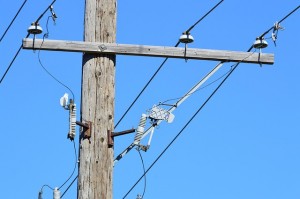 Print a Sign-In Sheet | Spanish Version
Print a Sign-In Sheet | Spanish Version
The Occupational Safety and Health Administration (OSHA) has established standards for the safe operation of cranes near power lines.
Line Clearance Distance
OSHA’s Electric Power Generation, Transmission, and Distribution Standard 29 CFR 1910.269 limits crane operations to a minimum clearance distance of 10 feet from power lines and related equipment energized up to 50 kilovolts (50,000 volts). For power lines and equipment energized at more than 50 kV, the distance is 10 feet plus 4 inches for every 10 kV over 50 kV.
Safe Working Clearance Distance
OSHA’s minimum line clearance determines only the closest distance that any equipment or material can get to an overhead power line. It does not determine the safe working clearance distance. The safe working clearance distance is determined by adding a crane’s furthest reach, including the extension of any load, to the line clearance distance. For example, if a crane with a 100-foot boom is working near a power line that has a line clearance distance of 10 feet, the crane should be placed 110 feet from the power line. A 100-foot crane located 50 feet from a power line still has the potential to come in contact with the line. The safe working clearance eliminates this risk and should be used whenever possible.
Under no circumstances should equipment or personnel be closer than OSHA’s line clearance distance unless the utility has de-energized and visibly grounded the power lines and informed the appropriate personnel that the lines no longer pose a threat.
Contact with Power Lines
If the crane or mast comes in contact with a power line, the operator should swing the boom into the clear. If it is necessary to leave the equipment, anyone on the machine should jump entirely clear of the unit. Keep your feet close together and jump so that both feet hit the ground at the same time. Walk away in a small-step shuffle because a large amount of electricity flowing into the ground can create differences in electrical potential — enough difference to actually shock anyone whose feet are too far apart. Once clear of the equipment, do not return for any reason until the power line has been grounded and/or determined to be safe by the electric utility or owner of the line. Prevent personnel from touching or approaching the equipment.
All employees should be trained regarding safety-related work practices and procedures as required in the Electric Power Generation, Transmission, and Distribution standard.
KEMI does not assume liability for the content of information contained herein. Safety and health remain your responsibility. This information is to be used for informational purposes only and not intended to be exhaustive or a substitute for proper training, supervision, or manufacturers’ instructions/recommendations. KEMI, by publication of this information, does not assume liability for damage or injury arising from reliance upon it. Compliance with this information is not a guarantee or warranty that you will be in conformity with any laws or regulations nor does it ensure the absolute safety of any person, place, or object, including, but not limited to, you, your occupation, employees, customers, or place of business.

